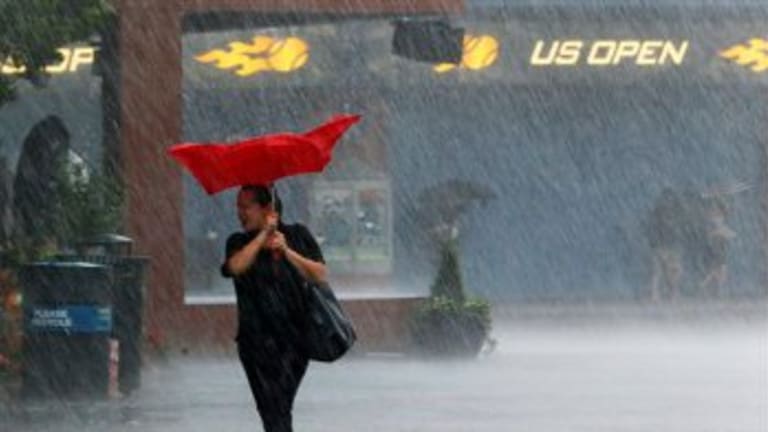NEW YORK—While wild reports circulated of a tornado touching down nearby in Queens, and the massive oaks lining the promenade between the South Gate of the National Tennis Center and the iconic Unisphere swayed and groaned in the wind, Tomas Berdych and Andy Murray played a match under what might have been the absolute worst conditions any pair of Grand Slam semifinalists has ever faced.
The decision to put the match on, and to allow it to continue with gusts strong enough to topple chairs and send towels flying across Arthur Ashe Stadium, was a difficult one to start with—you can, after all, play tennis under horrific conditions so long as it isn’t wet. But it was made tougher by the fact that without a roofed stadium, the failure to complete both men’s semifinals on Saturday (the women’s final has already been rescheduled for Sunday) guaranteed that for the fifth consecutive year, the men’s final would be played on Monday.
But the race to beat the rain—and potentially, more tornadoes—was halted in its tracks soon after Murray beat Berdych in four sets. David Ferrer had surprisingly jumped to a 5-2 first-set lead over Novak Djokvoic in the second semifinal when, at 5:16 p.m., the tournament referee decided to postpone the match and end play for the day (and evening) because of the severe weather forecast to hit New York City by around 6 p.m.
So there you have it. A fifth Monday final. In a row.
The real culprit in this ongoing tale of woe—or semi-woe, given the fact that Monday finals don’t exactly take place in a vacuum—is the absent one: The much-discussed roof. Although Rod Laver Arena at the Australian Open was the landmark, first roofed stadium at Grand Slam tournament, it was Wimbledon’s decision to enclose the Centre Court (if needed) that proved the tipping point in the narrative. Once that famed, sacrosanct arena was fitted with a roof (and a gorgeous piece of engineering it is), it seemed that the U.S. and French Opens were somehow outdated and outmoded.
But let’s put a halter on this obsession with a roof before it runs any further. World Series baseball games have been pushed back a day or more because of rain, and rounds of pro golf have been cancelled because of inclement weather. Same with outdoor concerts, and recently the Democratic party claimed to have moved President Barack Obama’s nomination acceptance from an outdoor stadium into a much smaller indoor venue because of the threat of rain.
Rain is inconvenient. Rain is a buzzkill. But as nice as it is to complete a tournament on time, and to be able to offer paying customers (at least those who pony up for stadium tickets) tennis on any day, rain or shine, rain is a regular feature of any outdoor activity. My own family camping trip was ruined by unexpected rain a few weeks ago; they still haven’t figured out how to put a roof over Indian Lake in the Adirondack mountains, although I’m not sure you needed to know that.
As powerful as the drive for a roofed stadium at the National Tennis Center has become, it’s still legitimate to ask if it’s necessary. One factor to keep in mind right off the bat is that no matter how the USTA has analyzed the revenue lost, or additional costs of adding an extra day to the tournament, adding a roof (in any number of scenarios) simply isn’t cost effective.
I don’t think that’s why the USTA has balked at keeping up with the British and Aussie Joneses. It’s also a fact that simply biting the bullet and putting a roof on Ashe is unfeasible for four major reasons:
1. The poor (read: unstable) soil beneath the National Tennis Center.
2. The span and size of the stadium. In the upper bowl, the span is five times that of Wimbledon’s space.
3. Potential air-control problems. Experts determined that a roof could raise the temperature on Ashe Stadium by 15 degrees in 15 minutes if it were roofed, which would necessitate retrofitting an elaborate air-conditioning system.
4. And the biggest problem of all—the sheer weight of the stadium with a roof would make the entire place unsafe.
You may remember that I wrote about the USTA’s ambitious renovation plan in a recent post. One potential solution, if the USTA decided it absolutely must have a roofed stadium, might be to reduce the size of gargantuan Ashe by removing the upper bowl (as was done with Louis Armstrong Stadium when Ashe was built) and make the projected new Armstrong stadium the effective center court. It’s just a matter of role reversal.
The USTA seems wedded to retaining Ashe as the largest dedicated tennis venue on the planet, and it has been reluctant to begin selling separate tickets to the different show courts. But the Australian and British models, which spread the action around on a number of subordinate stadia, seems to be ideal for tennis—a sport that until the final days of an event simply offers too much for any ticket-holder to watch, never mind digest.
I don’t think this potential change of plans, or the down-sizing of Ashe, is an easy or cheap fix—that creature doesn’t exist. But it would seem an idea worth exploring, given that the USTA is dedicating $500 million (yet to be secured) to the planned renovation.
